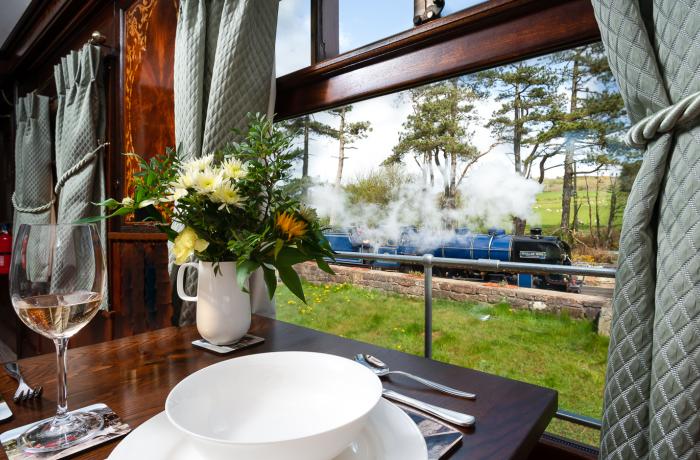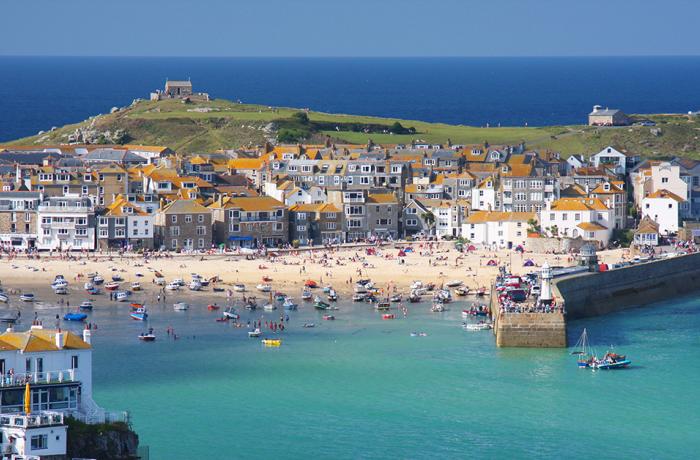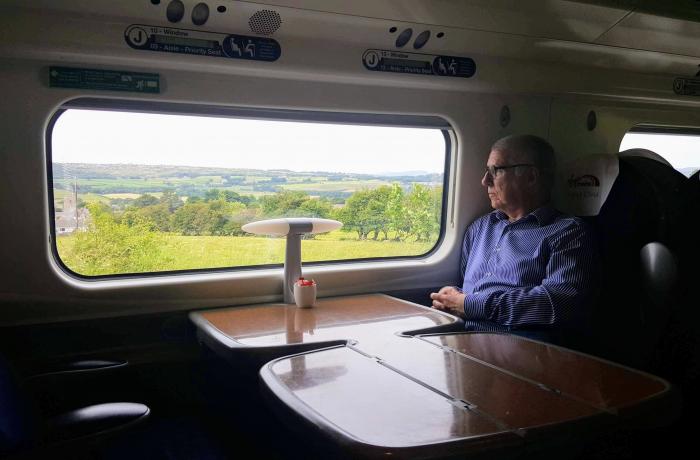The Rails Less Travelled
London-Guildford via Epsom & London-Guildford via Oxshott
For up to date guidance on travelling on public transport please see the latest government advice relevant to what region you're in: England, Scotland, Wales. Please check before you travel.
By guest blogger, Daniel Wright
Two hidden gems on the London commuter network connect to countryside and National Trust properties on scenic routes through Surrey.
The fastest way to get from London to Guildford is on one of South Western Railway's express trains to Portsmouth. It's less than an hour from the heart of London to the heart of the Surrey stockbroker belt. But an even better way, if scenic rail journeys and sustainable tourism are your thing, is to take either of South Western Railway's two alternative routes between London and Guildford.
Both of these rails less travelled are a much more interesting way to get between the two places, with views of beautiful countryside along the way and easy access to green spaces and historic National Trust properties.
If you take a bike with you, there's even more to see and do within an easy cycle of some of the stations. Trains on these two alternatives to the main line take longer to complete their journeys, stopping at more stations on the way, but both are hidden gems of the commuter network south of London. Scenic rail journeys aren't just the preserve of Britain's wilder extremities; these two are within easy reach of London and the southern Home Counties.
The London Waterloo to Guildford via Epsom train starts off running down the same main line as the fast trains to Guildford and Portsmouth. It makes its way through the tangle of tracks out of Waterloo and through Clapham Junction, but branches off the main line near Raynes Park. Once it clears London, the edge of the green belt marks a sudden change from London suburbia to open countryside.
Crossing into Surrey (claimed to be England's most wooded county) the train stops off at characterful market towns like Epsom and Leatherhead. Look out for the view of the River Mole just south of Leatherhead station as the train crosses the river high up on a bridge.
Then, just 50 minutes from London is Bookham station. Cross over the station footbridge onto platform 1, and you'll find a gate which leads directly onto the National Trust's Bookham Commons – how's that for convenience?
Over 380 acres of woodland and grassland are criss-crossed by footpaths, and if you get tired of walking there are plenty of benches to sit on and admire the sights, sounds and scents of the Commons.
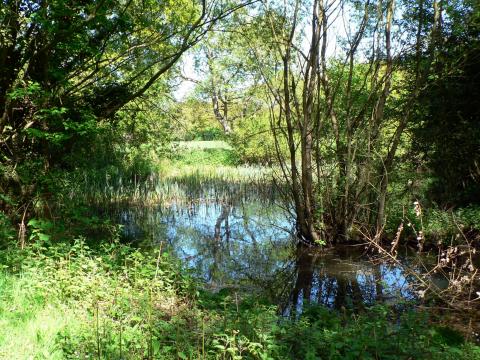
Shallow ponds (actually bomb craters from when the Commons were used as a military site during the Second World War) buzz with dragonflies and damesflies during spring, summer and early autumn.
The Commons are also a good site for woodland butterflies and one of the best places in Britain to see rare Purple Admirals, though they spend a lot of their time in the tree tops; your best bet is to sit quietly by a pond or puddle and hope they come down to drink.
If you have your bike with you, it's only two and half miles of gentle cycling from Bookham station to the National Trust's Polesden Lacey.
The Edwardian mansion will interest country house lovers while the grounds have plenty of walks. And of course, there's a café to refresh yourself after your cycle.
For bike-riding families, Bookham station is also only two and half miles from Bocketts Farm Park. At this open farm you can feed the animals, watch the pig racing (it's hilarious, and really it's just a way of giving the pigs some exercise as they race towards their next feed), take a tractor ride, while younger members of the family can burn off some energy in the play areas.
Continuing from Bookham towards Guildford, the next station is Effingham Junction. It's here that the London to Guildford via Epsom line meets the third way of getting from London to Guildford by train, this time the line via Oxshott. It's a bit quicker than the route via Epsom, branching off the main line at Surbiton station, one of Britain's most significant Art Deco railway stations.
As soon as you hit the greenbelt near Claygate it's a route that runs through lush countryside, woodlands and gently rolling fields. It feels extraordinarily rural for an area that's only just outside Zone 6 of the London rail network.
You can see deer on most journeys, which tend to stand stock still and watch the trains going past, as well as rabbits (lots of) and pheasants (even more – especially in winter when they're not hidden by long grass). If you're watching out for them, you're very likely to see Buzzards gliding over the fields, and the occasional (but increasingly often observed) Red Kite.
Claygate station itself has an unusual claim to fame, although it's a stop-off you might want to save until you're on the way home. Platform 3 is housed in a tiny old railway building on the station's forecourt and claims to be the smallest pub in the UK. It's so small that there's only enough room inside to serve the drinks – all the seating is outside so take an extra layer if the evening is cool.
The next station on the line, Oxshott, is immediately adjacent to Oxshott Heath. This 200-acre heathland and woodland is a great space for family nature activities like bug hunting, with plenty of tree trunks to roll over and see what's hiding underneath. If you're really committed to exploring the local area by train, the station house is a holiday cottage to rent, but move quickly as it's also being offered for sale.
After Effingham Junction, where the 'via Epsom' and 'via Oxshott' lines meet, comes Horsley. East Horsley, the village actually served by the station, is a charming little place to have a look around.
If it's time to eat, then there is an excellent Italian restaurant (at least it was the last time I ate there) called La Meridiana in what used to be the Railway Hotel. I could never figure out why a little village like East Horsley needed a railway hotel that large though; it's a reminder of the heyday of the railway during the late 19th and early 20th Centuries. East Horsley is notable for the many houses and buildings built or rebuilt in an idiosyncratic flint and terracotta style under the auspices of local landowner the 1st Earl of Lovelace in the mid-1800s. He also built numerous bridges in similar style in the surrounding woodlands to assist with his forestry operations and the trail around these makes for an intriguing country walk full of local history.
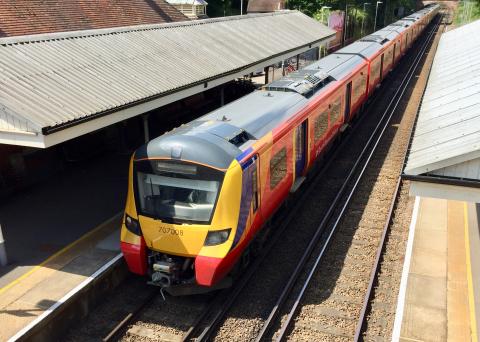
Clandon is the next stop along the line. It's just over a mile, along a flat walk, from the station to the National Trust's Clandon Park.
The gardens are lovely but it's most famous for the house itself suffering a devastating fire in 2015. There is now an unusual opportunity to see the National Trust at work restoring and remaking the house.
Alternatively, it's an easy 15-20 minute, 3-mile bike ride from Clandon station to the National Trust's Hatchlands Park, a country house with a notable collection of historic keyboard instruments set in large grounds.
The bluebell wood there flowers in late spring and is a favourite local attraction with a haze of purple-blue flowers carpeting the woodland in every direction.
After Clandon comes a final run through fields and woodland before the train reaches Guildford's eastern suburbs. The final stop before Guildford itself is London Road, where you can leave the train for one final National Trust property.
Just under a mile's walk away through the streets of Guildford is Dapdune Wharf, a complete contrast from the stately homes further up the lines. This historic wharf on the River Wey Navigations has a small museum which tells the story of how the river was used to transport goods before the railways came to Surrey, and the life of the bargees who made their livelihoods on it.
Today, regular passenger boat trips operate along a short length of the River Wey from Dapdune Wharf and there are walks running for miles along the river banks of the Wey Navigations.
Guildford's main station hoves into view soon after London Road, once the train has navigated a sharply curving viaduct that gives views over the town and up to Guildford Cathedral. At Guildford, you'll meet up again with the Portsmouth-bound express trains from Waterloo. Their passengers might have got to Guildford more quickly than you, but they'll have missed all the interesting things you've seen and done.
About the author
Daniel Wright is a community rail support officer for Community Rail Network. Away from work, Daniel writes about transport architecture and design, and transport's impact on wider culture.
For up to date guidance on travelling on public transport for leisure please check the latest government advice relevant to what region you're in: England, Scotland, Wales. Please check before you travel.
Subscribe to our blog posts. We are planning to post about once a month. We will never share your details and you can unsubscribe with a single click.


